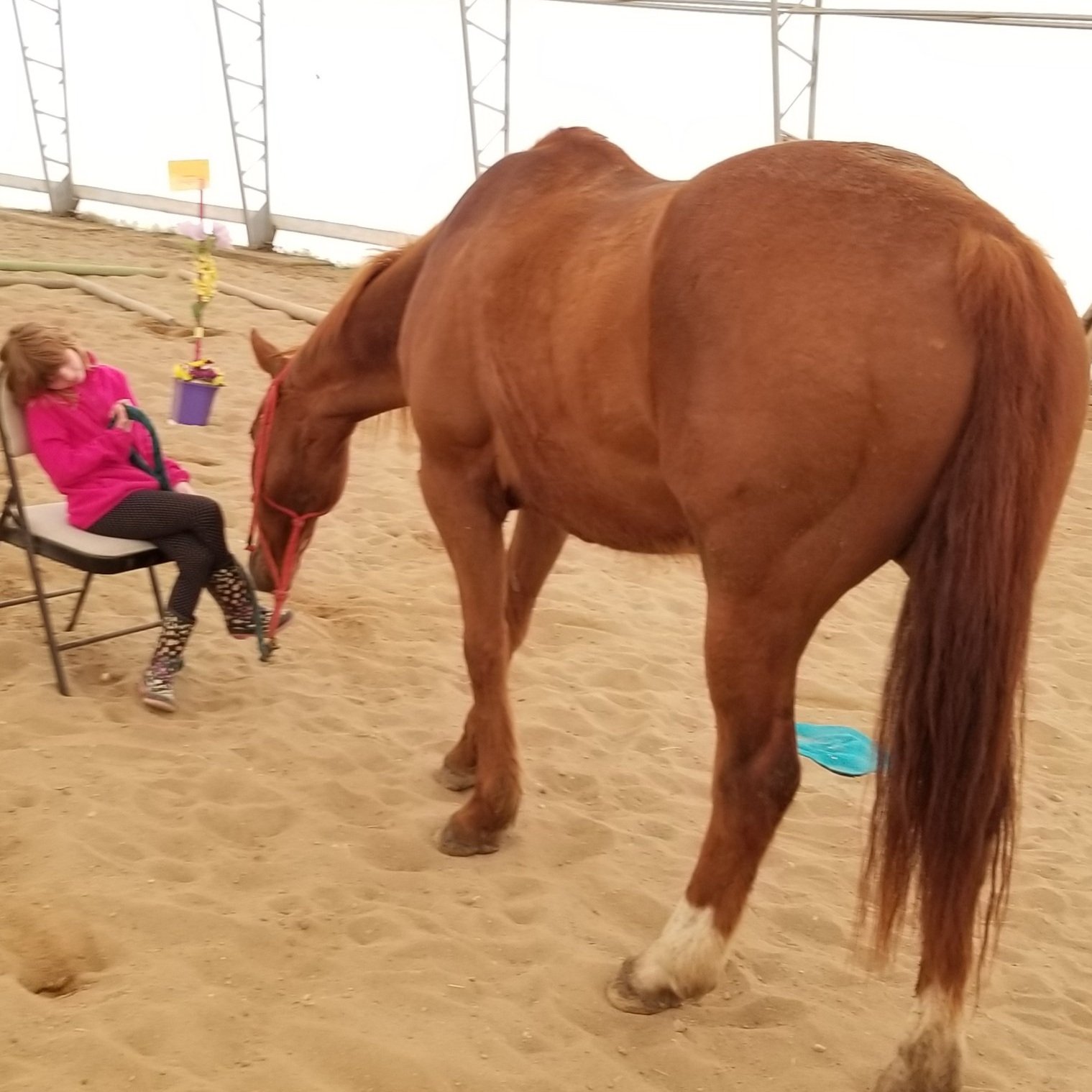Equine Assisted Psychotherapy – EAP
“What is the bravest thing you have ever said?” asked the boy. “Help,” said the horse.
-Charlie Mackesy
Equine-Assisted Psychotherapy (EAP)
EAP is a therapeutic practice that uses horses as a primary source of support to help clients learn about themselves and the world around them (Bark, 2011). Bark (2011) explains that clients embark on a journey with a horse to understand themselves and the world around them. EAP is a therapeutic practice that uses horses as the primary tool for practitioners to achieve specific treatment goals for their clients (Barnstable, 2022; Robinson, 2022). EAP is an on-ground practice that does not explicitly focus on horseback riding, which may require more emphasis from the counsellor for instruction and direction (Bark, 2011). EAP is a collaborative process involving a licensed mental health professional, an equine specialist (a person who is competent in equine behaviour), and therapy horses to address psychotherapeutic objectives (Stapleton & Grimmett, 2021). The goal is to encourage clients to open up, focus on the moment, and express their thoughts or feelings (Bark, 2011; Stapleton & Grimmett, 2021). Horses can be an affirming experience for clients, as they believe they are worthwhile and actively seek to build relationships with them (Coffin, 2019). This approach can help clients feel more supported and understood.
EAP therapies go beyond simply petting a horse; they create a relationship between horse and client to create bonds, trust, respect, and responsibility (Bark, 2011). Youth who work with animals often begin sessions with an open mind and sense of belonging, regardless of their history (Flynn et al., 2020). EAP often uses CBT, person-centred, or psychoanalytical therapies, with a horse as a co-facilitator, fostering qualities such as trust, respect, and responsibility in clients (Robinson, 2022; Barnstable, 2022). Hershberger's (2022) study highlights the importance of attachment in equine programs, suggesting that horses can serve as co-therapists and sources of healing attachment for participants, facilitating treatment goals and promoting understanding and security. Not all horses are suitable for EAP work, as they need positive attitudes, good manners, reliability, adaptability, flexibility, and previous training and experience (Robinson, 2022; Barnstable, 2022; Bark, 2011).
EAP aims to enhance personal confidence and self-esteem through qualified, certified practitioners skilled in horse behaviours, actions, and reactions, with the primary goal of enhancing self-esteem. (White-Lewis, 2019; Robinson, 2022; Barnstable, 2022). Therapists must be proficient in reading people and horses and conveying body language and communication to support clients' healing journeys (Robinson, 2022; Barnstable, 2022). Counsellors in EAP require specific training, professional competencies like horse knowledge, risk management, equine-specific training, and advocacy for equines and clients' wellness, as well as personal competencies like self-awareness and authenticity (Hershberger, 2022).
Horses play a crucial role in therapeutic sessions, allowing clients to express emotions and provide the therapist feedback (Baratti, 2021). In an EAP session, a licensed practitioner uses a horse as a cofacilitator, making it an active and valuable partner in therapy (Stapleton & Grimmett, 2021). The horse directly links to the client's feelings in a less threatening manner (D'Agostino, 2019). The connection with horses helps therapists better understand clients' emotional states, providing a less direct and often less threatening communication tool, allowing the therapist to gain information that may not be available through direct questioning (D'Agostino, 2019). Unlike traditional talk therapy, EAP reduces reliance on verbal communication and leads to less intrusive engagement, according to D'Agostino (2019) & Stapleton and Grimmett (2021). Pelyva et al. (2020) and Adams et al. (2015) found that animal (including horse) interactions significantly change behavioural development and emotional wellness in individuals. This behavioural development is due to the comfort and safety provided by the gentle nature of the equine interactions, which can help initiate a child's healing journey.
Stephanie Lockhart
References
Adams, C., Arratoon, C., Boucher, J., Cartier, G., Chalmers, D., Dell, C. A., Dell, D., Dryka, D., Duncan, R., Dunn, K., Hopkins, C., Longclaws, L., MacKinnon, T., Sauve, E., Spence, S., & Wuttunee, M. (2015). The helping horse: How equine assisted learning contributes to the well-being of first nations youth in treatment for volatile substance misuse. Human-animal Interaction Bulletin, 1(1), 52–75. https://www.ncbi.nlm.nih.gov/pmc/articles/PMC4716821/
Baratti, N. (2021, June 7). Community Spotlight: Rocky Hill Stables & the HALT Foundation. WHSV3. https://www.whsv.com/2021/06/07/community-spotlight-rocky-hill-stables-halt-foundation/
Bark, J. (2011). Therapists working together with horses equine assisted psychotherapy: Treating youths with addiction. https://www.diva-portal.org/smash/get/diva2:499300/FULLTEXT01.pdf
Barnstable, J. (2022, May 5). Equine-assisted psychotherapy promotes resilience in children and adolescents impacted by interpersonal trauma. Retrieved September 18, 2022, from https://repository.cityu.edu/handle/20.500.11803/1759
Coffin, J. (2019). The Nguudu Barndimanmanha Project-improving social and emotional well-being in aboriginal youth through equine-assisted learning. Frontiers in Public Health, 7. https://doi.org/10.3389/fpubh.2019.00278
D’Agostino, F. J. H. (2019, August). Equine-assisted psychotherapy for childhood trauma: a randomized controlled trial of the EAGALA model. DigitalCommons@Pace. Retrieved September 17, 2022, from https://digitalcommons.pace.edu/dissertations/AAI27545495/
Flynn, E., Gandenberger, J., Mueller, M.K., Morris, K. N., (2020). Animal-assisted interventions as an adjunct to therapy for youth: Clinician perspectives. Child and Adolescent Social Work Journal. https://doi.org/10.1007/s10560-020-00695-z
Hershberger, J. M. (2022). “It’s like Bluetooth. I felt like I was in rhythm with him:” An Interpretative Phenomenological Analysis (IPA) of the lived experiences of Commercially Sexually Exploited Youth (CSEY) in a residential Equine Assisted Psychotherapy (EAP) program. [Doctor of Philosophy, North Dakota State University of Agriculture and Applied Science]. https://r.search.yahoo.com/_ylt=AwrFAWiXsMpl1YgAUR1XNyoA;_ylu=Y29sbwNiZjEEcG9zAzEEdnRpZAMEc2VjA3Ny/RV=2/RE=1707811095/RO=10/RU=https%3a%2f %2flibrary.ndsu.edu%2fir%2fbitstream%2fhandle%2f10365%2f33515%2fHershberger_ ndsu_0157D_13164.pdf%3fsequence%3d1/RK=2/RS=uRCLHYthSi5bXqaBg3wu_0NQ wyE-
Pelyva, I. Z., Kresák, R., Szovák, E., & Tóth, Á. L. (2020). How equine-assisted activities affect the prosocial behaviour of adolescents. International journal of environmental research and public health, 17(8), 2967. https://doi.org/10.3390/ijerph17082967
Robinson, S. (2022, May). Equine assistance as a psychotherapy tool for adolescents with trauma experiences. RED: A Repository of Digital Collections. Retrieved September 18, 2022, from https://red.mnstate.edu/thesis/663/
Stapleton, P., & Grimmett, K. T. (2021). Australian community and health professionals’ perceptions of equine-assisted psychotherapy. Evidence-Based Complementary & Alternative Medicine (ECAM), 1–16. https://doi.org/10.1155/2021/2217761
White‐Lewis, S. (2019, September 27). Equine‐assisted therapies using horses as healers: A concept analysis. Nursing Open, 7(1), 58–67. https://doi.org/10.1002/nop2.377




